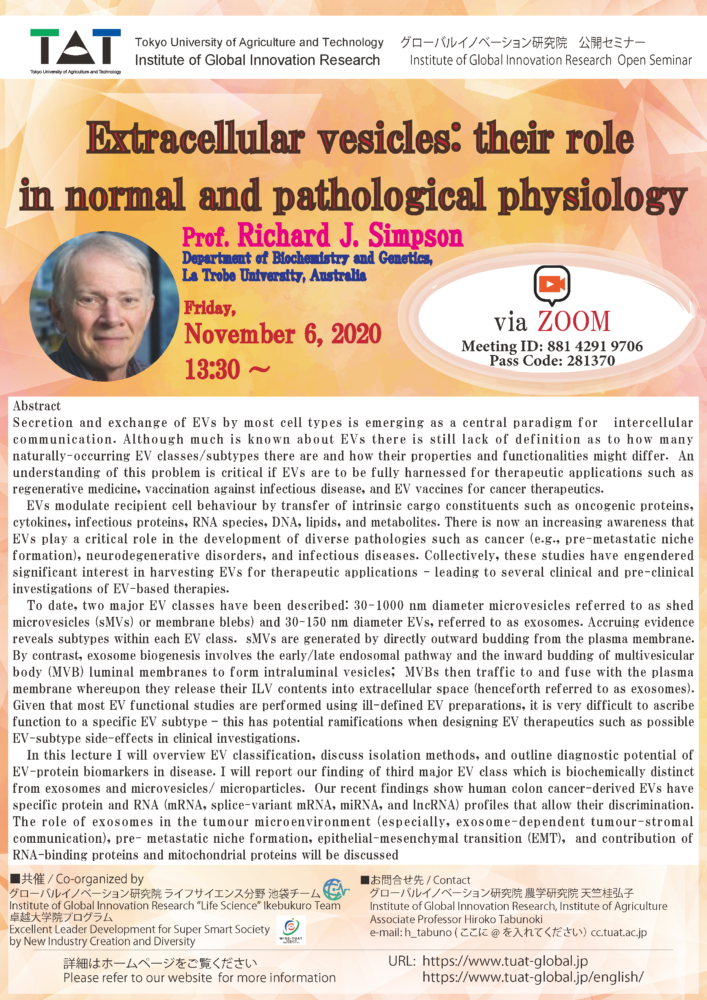イベント情報
オンラインセミナー【GIR公開セミナー】 Prof. Richard J. Simpson / ラトローブ大学(オーストラリア)”Extracellular vesicles: their role in normal and pathological physiology”

| 日時 | 2020.11.6(13:30~未定) |
|---|---|
| 会場 | |
| 講演タイトル | ※本セミナーはZoomにてご参加いただけます。 ( 後日、Google Classroomでも公開いたします。) Zoomミーティングにアクセス (11⽉6⽇13時からリンクに⼊れます。) ミーティングID: 881 4291 9706 パスコード: 281370 ------------------------------------------------------------------------------------------------------------------------------ Dr. Richard J. Simpson Distinguished professor Department of Biochemistry and Genetics La Trobe University, Australia [概要] Secretion and exchange of EVs by most cell types is emerging as a central paradigm for intercellular communication. Although much is known about EVs there is still lack of definition as to how many naturally-occurring EV classes/subtypes there are and how their properties and functionalities might differ. An understanding of this problem is critical if EVs are to be fully harnessed for therapeutic applications such as regenerative medicine, vaccination against infectious disease, and EV vaccines for cancer therapeutics. EVs modulate recipient cell behaviour by transfer of intrinsic cargo constituents such as oncogenic proteins, cytokines, infectious proteins, RNA species, DNA, lipids, and metabolites. There is now an increasing awareness that EVs play a critical role in the development of diverse pathologies such as cancer (e.g., pre-metastatic niche formation), neurodegenerative disorders, and infectious diseases. Collectively, these studies have engendered significant interest in harvesting EVs for therapeutic applications - leading to several clinical and pre-clinical investigations of EV-based therapies.. To date, two major EV classes have been described: 30-1000 nm diameter microvesicles referred to as shed microvesicles (sMVs) or membrane blebs) and 30-150 nm diameter EVs, referred to as exosomes. Accruing evidence reveals subtypes within each EV class. sMVs are generated by directly outward budding from the plasma membrane. By contrast, exosome biogenesis involves the early/late endosomal pathway and the inward budding of multivesicular body (MVB) luminal membranes to form intraluminal vesicles; MVBs then traffic to and fuse with the plasma membrane whereupon they release their ILV contents into extracellular space (henceforth referred to as exosomes). Given that most EV functional studies are performed using ill-defined EV preparations, it is very difficult to ascribe function to a specific EV subtype – this has potential ramifications when designing EV therapeutics such as possible EV-subtype side-effects in clinical investigations. In this lecture I will overview EV classification, discuss isolation methods, and outline diagnostic potential of EV-protein biomarkers in disease. I will report our finding of third major EV class which is biochemically distinct from exosomes and microvesicles/ microparticles. Our recent findings show human colon cancer-derived EVs have specific protein and RNA (mRNA, splice-variant mRNA, miRNA, and lncRNA) profiles that allow their discrimination. The role of exosomes in the tumour microenvironment (especially, exosome-dependent tumour-stromal communication), pre- metastatic niche formation, epithelial-mesenchymal transition (EMT), and contribution of RNA-binding proteins and mitochondrial proteins will be discussed. [文献] Extracellular vesicles in cancer—implications for future improvements in cancer care R Xu et al., RJ Simpson 2018 Nature Reviews Clinical Oncology (PMID: 29795272); R Xu et al., RJ Simpson 2016 J Clinical Investigation (PMID: 27035807) Proteomic profiling reveals key cancer progression modulators in shed microvesicles released from isogenic human primary and metastatic colorectal cancer cell lines Suwakulsiri W et al., & Simpson RJ (2018) BBA -Proteins and proteomics 1867 (12), 140171 (PMID: 30502510) Surfaceome of exosomes secreted from the colorectal cancer cell line SW480: Peripheral and integral membrane proteins analyzed by proteolysis and TX114 R Xu, DW Greening, M Chen, A Rai, H Ji, N Takahashi &, RJ Simpson Proteomics, 2019 Exosomes derived from human primary and metastatic colorectal cancer cells contribute to functional heterogeneity of activated fibroblasts by reprogramming their proteome A Rai, DW Greening, M Chen, R Xu, H Ji, RJ Simpson - Proteomics, 2019 Distinct shed microvesicle and exosome microRNA signatures reveal diagnostic markers for colorectal cancer M Chen, R Xu, A Rai, W Suwakulsiri, K Izumikawa & RJ Simpson PloS one 14 (1), e0210003 Understanding extracellular vesicle diversity–current status DW Greening & RJ. Simpson (2018) Expert Review of Proteomics, 15:11, 887-910, DOI: 10.1080/14789450.2018.1537788 Exosomes Derived from the Human Primary Colorectal Cancer Cell Line SW480 Orchestrate Fibroblast‐Led Cancer Invasion A Rai, DW Greening, R Xu, W Suwakulsiri, RJ Simpson - Proteomics, 2020 https://doi.org/10.1002/pmic.202000016 Exosomes derived from human primary and metastatic colorectal cancer cells contribute to functional heterogeneity of activated fibroblasts by reprogramming their proteome A Rai, DW Greening, M Chen, R Xu, H Ji, RJ Simpson - Proteomics, 2019 (PMID: 30582284) |
| 言語 | 英語 |
| 対象 | どなたでも、ご参加いただけます。 |
| 主催 | グローバルイノベーション研究院 ライフサイエンス分野 池袋チーム 卓越大学院プログラム |
| 開催概要 | |
| お問い合わせ窓口 | グローバルイノベーション研究院 農学研究院 天竺桂 弘子 e-mail: h_tabuno ( ここに@ を入れてください) cc.tuat.ac.jp |
このページの上部へ